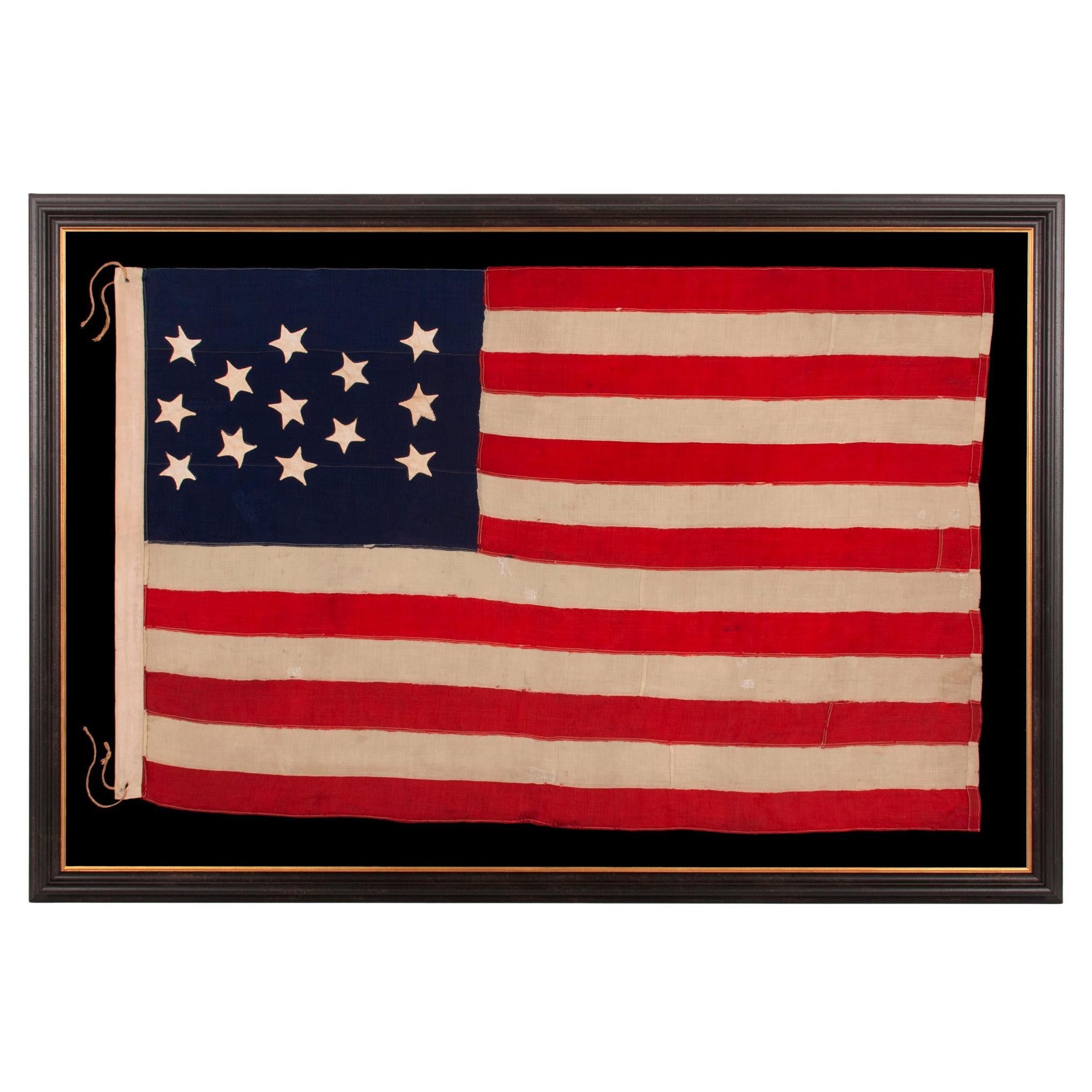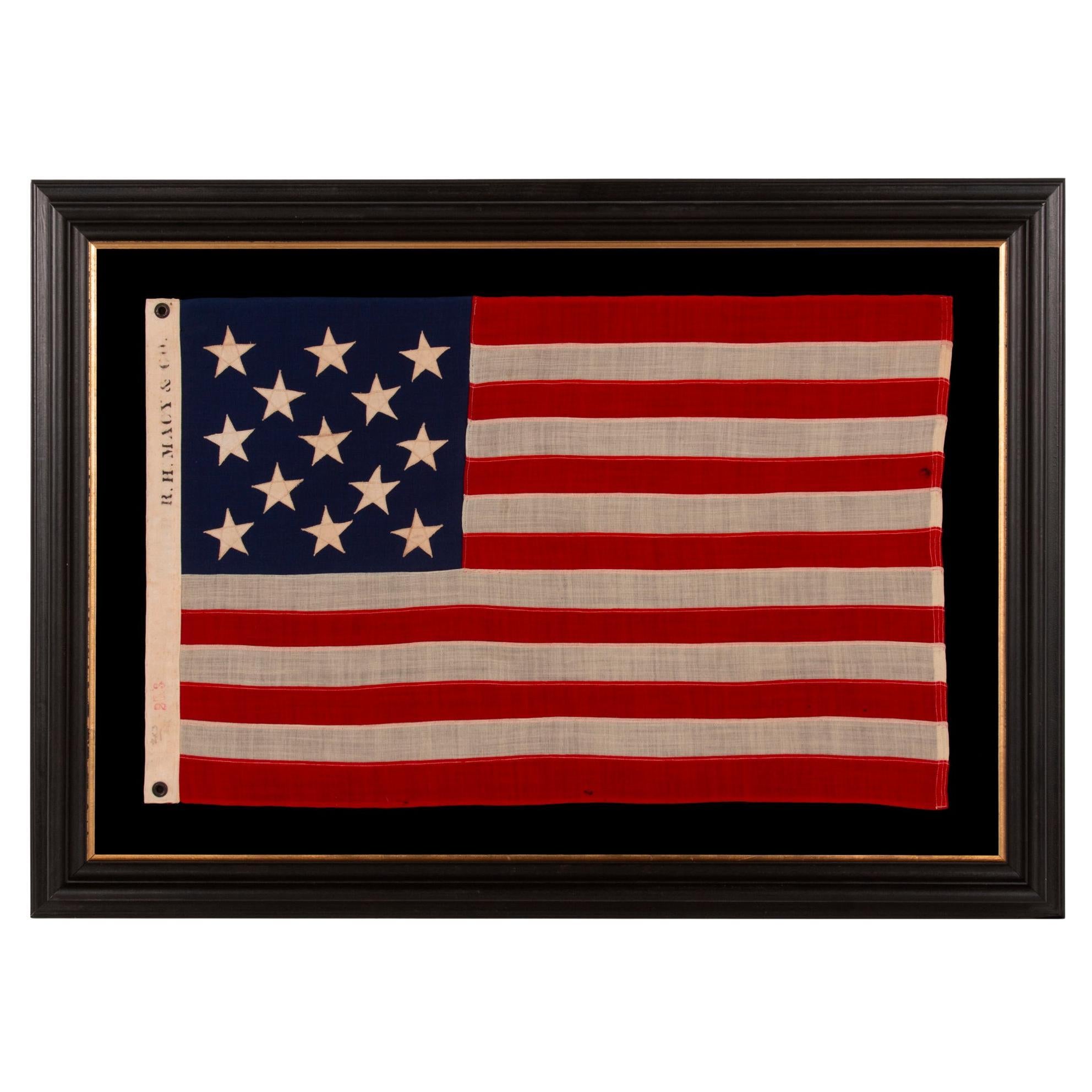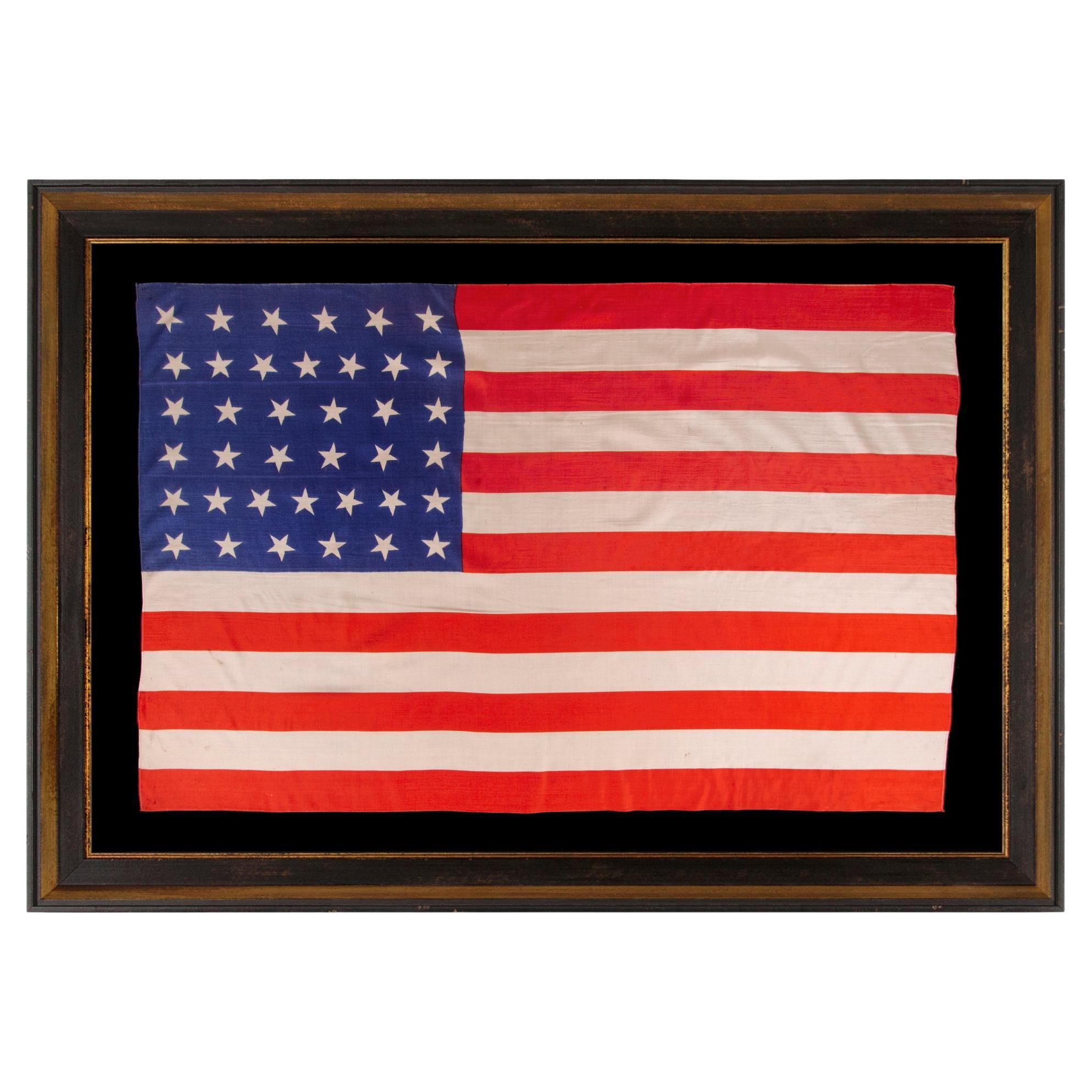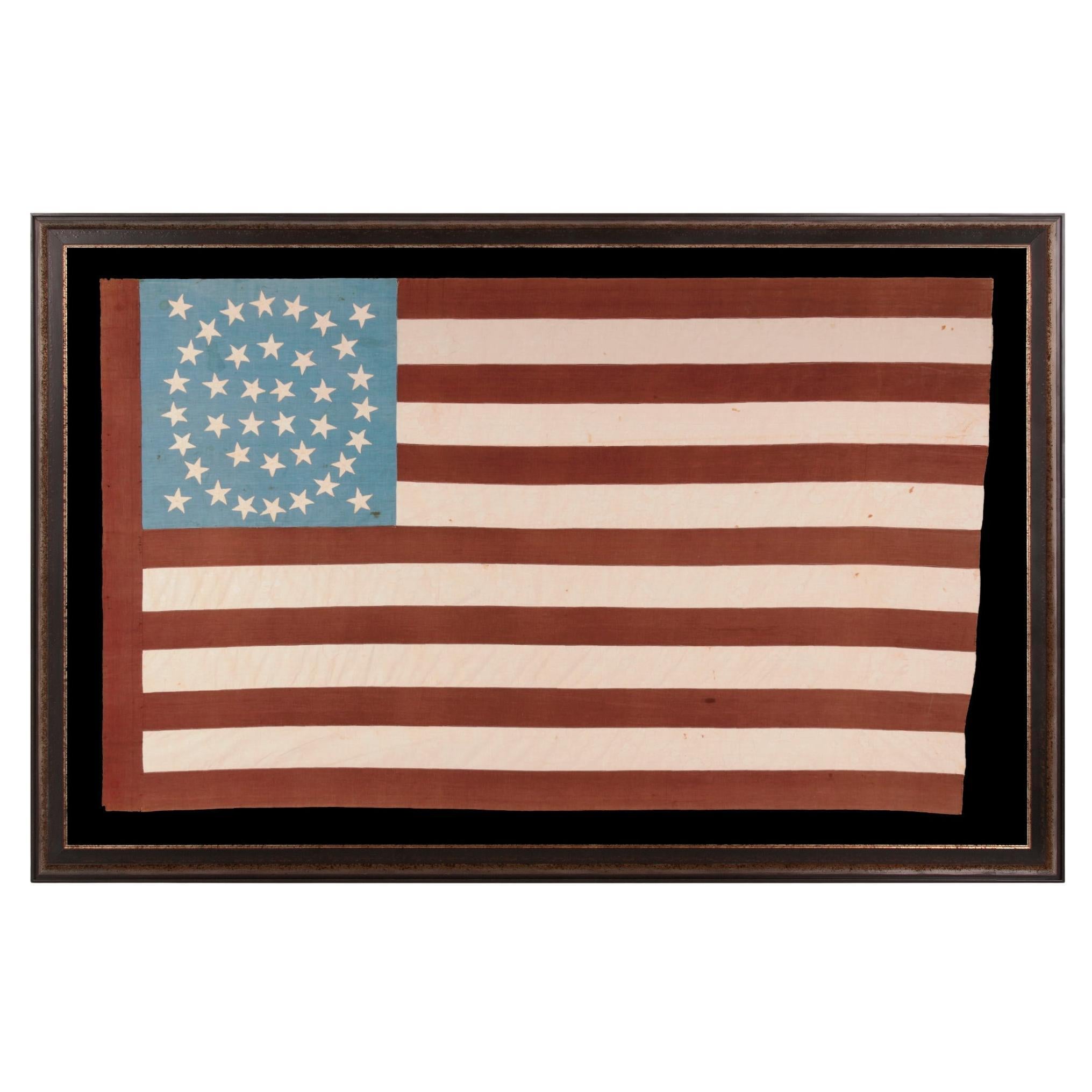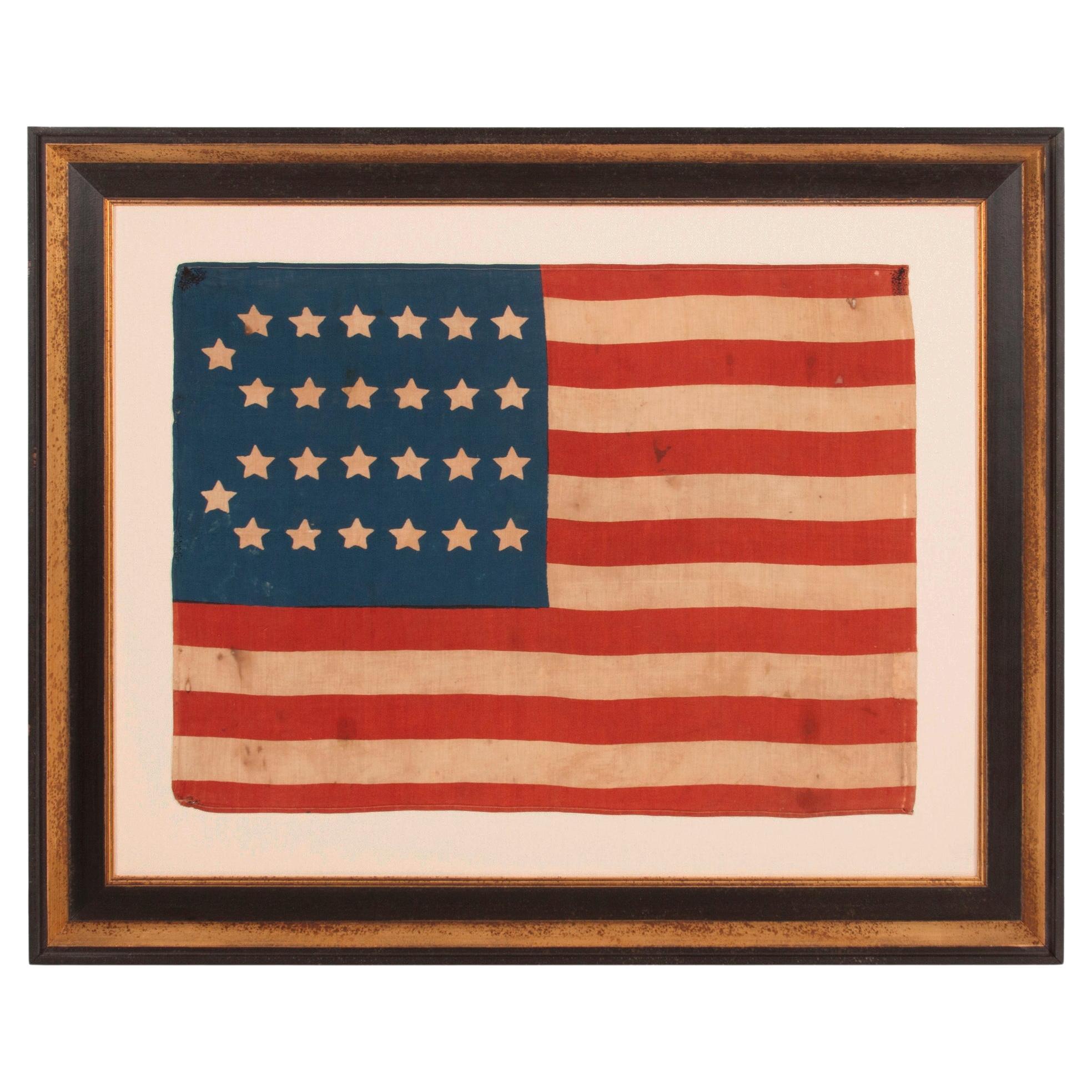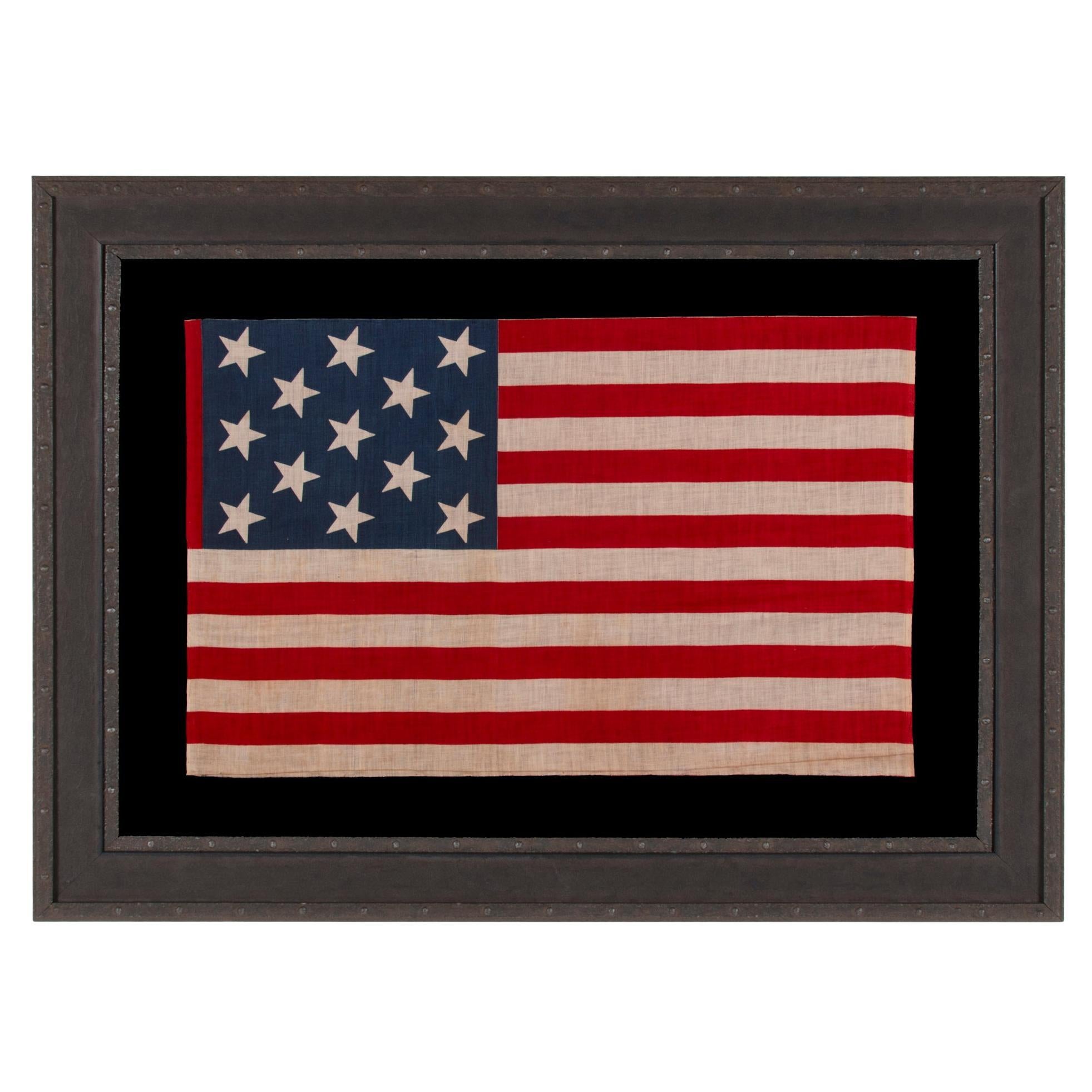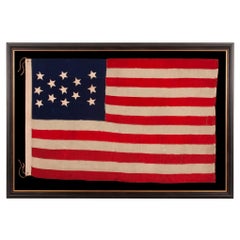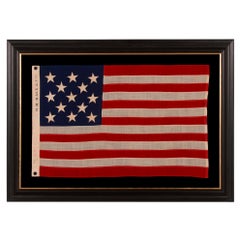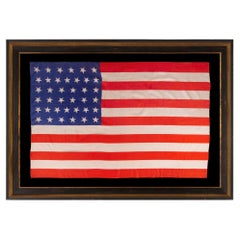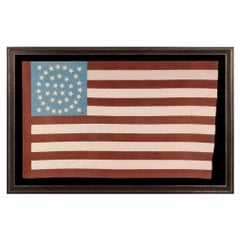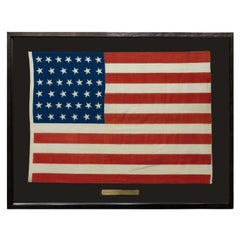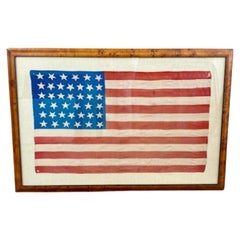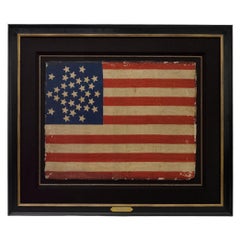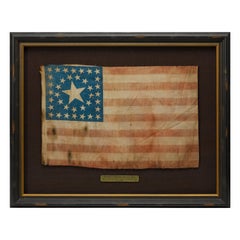Items Similar to 38 Star Antique American Flag; Extremely Rare; Indian Wars, US Army Flank Guidon
Want more images or videos?
Request additional images or videos from the seller
1 of 6
38 Star Antique American Flag; Extremely Rare; Indian Wars, US Army Flank Guidon
Price Upon Request
Price Upon Request
Price Upon Request
Price Upon Request
Price Upon Request
Price Upon Request
Price Upon Request
Price Upon Request
Price Upon Request
Price Upon Request
Shipping
Retrieving quote...The 1stDibs Promise:
Authenticity Guarantee,
Money-Back Guarantee,
24-Hour Cancellation
About the Item
RARE AND BEAUTIFUL 38 STAR ANTIQUE AMERICAN FLAG, AN INDIAN WARS PERIOD FLANK GUIDON OF THE 4th U.S. INFANTRY, WITH A MEDALLION CONFIGURATION SURROUNDING THE NUMERAL “4,” AND EXTRAORDINARY PRESENTATION FROM LEGITIMATE USE; REFLECTS THE PERIOD WHEN COLORADO WAS THE MOST RECENT STATE TO JOIN THE UNION, circa 1876-1889:
38 star flank guidon of the Indian Wars period, made of silk, with 38 embroidered, silk stars surrounding an embroidered numeral “4”. The stars are arranged in a beautiful, double wreath configuration, with a flanking star in each corner. Expertly hand-sewn throughout, with tiny stitches, the striped field and canton were rolled over, around a cotton lining, to form an open sleeve.
The “4” identifies the intended unit as the 4th U.S. Infantry. Infantry guidons of this sort were attached to a wooden staff, inserted through the sleeve and, in this instance, affixed with metal tacks. The pole fit down into the barrel of a rifle or musket, which, when shouldered by a soldier, displayed the flag and marked the end of the flank. Two were typically carried, one each to the left and right. This helped in the formation of troops and was a visual aid for officers.
Colorado became the 38th state on August 1st, 1876. This was the year of our nation’s 100-year anniversary of independence. Per the Third Flag Act of 1818, stars were not officially added until the 4th of July following a state's addition. For this reason, 37 remained the official star count until July 4th, 1877. Flag-making was a competitive venture, however, and no one cared what was official, not even the military, where the matter of practicality generally outweighed flag protocol. As soon as it was suspected that a new state was coming, stars were added by the makers of flags, both public and private. Some would have begun adding a star for the 38th state before it even entered the Union, in the early part of 1876, and almost none would continue to produce 37 star flags, when their competitors were making 38’s. It is of interest to note that some flag-makers were actually producing flags in the 39 star count in 1876, especially in printed cotton examples (called parade flags or hand-wavers), to reflect the anticipated addition of two new states instead of one, though only Colorado came. No further states followed until 1889. Manufacture of 38 star flags would have ceased in the fall of that year, when four new states entered in a period of just a week-and-a-half.
The numeric identification signifies the intended unit as the 4th U.S. Infantry. Interestingly enough, this regiment was particularly active in Colorado. One of its most notable actions involved a conflict with the Ute Indians. In September of 1879, Indian Agent N. C. Meeker, of the White River Agency (Colorado), became involved in a dispute with Northern Utes and requested assistance from the Army. In response, Major T. T. Thornburgh's column of some 200 men, including parts of the 5th Cavalry and 4th Infantry, set out from Fort Steele, Wyoming to assist. On September 29th, the force was attacked and besieged in the Red Canyon, by 300 to 400 Ute warriors. Thornburgh was killed in the melee. His command was finally relieved by elements of the 9th Cavalry, a Buffalo soldier unit, that arrived on October 2nd, and then by the remainder of the 5th Cavalry, under Colonel Wesley Merritt, that arrived on the October 5th. In the meantime, Agent Meeker was captured, tortured, and executed, and most of his staff were massacred. Before the Utes were pacified, in November of 1880, several thousand troops had taken the field. In 1906, the Utes of this area left their reservation and roamed through Wyoming, terrorizing the countryside, until they were forced back by elements of the 6th and 10th Cavalries (the latter of these also Buffalo soldiers).
It is of interest to note that I had the privilege of owning this flag about 20 years ago. At that time, it was viewed by American flag expert and museum curator, Howard Madaus, on an occasion when he visited me in Pennsylvania. During the course of our conversations, Madaus stated that he had recently uncovered a military order that contracted for the manufacture of flags of this same type, in 1888, and that he had seen 10, rolled up together, in an institutional collection. Our conversation drifted to other flags, and it is unfortunate that I never had the opportunity to re-revisit the subject with him, before he passed, in 2007. I would like to have inquired about exactly where, when, and by whom these—and any others that he knew to exist of this form—were likely to have been produced.
Including this example, I have owned four flags of this basic variety, and know of one other to survive. This is one of three made for the 4th infantry. I acquired and sold another 4th Infantry example, fringed in gold silk. Two of the remainder were made for the 2nd infantry, with that designation in the center of the medallion, in place of the numeral “4.” On one of these, the “2” had been removed, but the place in which it had formally been was clearly visible.
19th century Stars & Stripes of military production, made to be carried on foot, are extremely scarce in private hands. Of even greater interest, among this elite group, are those with a strikingly graphic presentation, ties to a historic unit, and/or in a small enough scale to easily frame and display. Infantry flank guidons are the basically the smallest type of flag, with pieced-and-sewn construction, that was produced with any regularity during the 19th century. Extremely rare, especially in a Stars & Stripes format, this particular example was an extraordinary find. During the Civil War, regulation Infantry guidons were solid color, with the unit designation, as opposed to being in the form of the national flag. Because they are not in the Stars & Stripes design, their marketability is generally limited to a military-focused audience of collectors.
Stars & Stripes guidons, whether made for infantry or cavalry, are extraordinarily rare in the 38 star period. In addition to what is mentioned above, I was privileged to own one infantry example, with no unit designation, as well as a forked swallowtail guidon, in a form known to have been made for the 2nd Massachusetts Cavalry. I believe I have seen as many as four swallowtail cavalry guidons, with 38 stars, in museum and state armory collections, but have not had the opportunity to revisit that particular piece of research, and there may be others. In rectangular format or swallowtailed, such flags are coveted by flag enthusiasts and, without doubt, a fantastic addition to any flag collection.
Mounting: The flag was mounted and framed within our own textile conservation department, which is led by expert staff. We take great care in the mounting and preservation of flags and have framed thousands of examples.
The two-part frame consists of an exceptional, antique, gilded, American molding of the 1820-1850 era, to which a modern, step-down profile molding, very dark brown in color, almost black, with reddish overtones and highlights, was added as a cap. This is a pressure mount between 100% cotton twill, black in color, and U.V. protective acrylic (Plexiglas). The black fabric has been washed and treated for colorfastness.
Condition: Silk flags were practical for land-use by military forces, due to their light weight, but seldom do they survive intact. In this case, the striations and fabric loss clearly represent legitimate field use, as well as the weighted silk fabric that was used in its construction. Silk of this period almost always experiences breakdown due to addition of weighting agents, added by creative merchants to make it heavier. This occurred in response to a change in the way that silk was sold, by weight as opposed to by length. These increased the amount of money that a merchant could obtain for the fabric, but were caustic to the fabric over time. Due to the rigors of military use during the 19th century, as well as the weighting agents, the state of the flag is expected. It is also a striking example, in-part because of the losses, that illustrate its age and the circumstances through which it survived to the present day. There is moderate bleeding of red dye in the first 5 white stripes, and modest of the same in the last white stripe. Many of my clients prefer early flags to show their age and history of use.
- Dimensions:Height: 27 in (68.58 cm)Width: 30.25 in (76.84 cm)Depth: 2 in (5.08 cm)
- Materials and Techniques:
- Place of Origin:
- Period:
- Date of Manufacture:1876-1889
- Condition:Wear consistent with age and use. See item description.
- Seller Location:York County, PA
- Reference Number:Seller: 38-0281stDibs: LU849745615182
About the Seller
5.0
Recognized Seller
These prestigious sellers are industry leaders and represent the highest echelon for item quality and design.
Established in 1991
1stDibs seller since 2008
70 sales on 1stDibs
Typical response time: Several days
- ShippingRetrieving quote...Shipping from: York County, PA
- Return Policy
Authenticity Guarantee
In the unlikely event there’s an issue with an item’s authenticity, contact us within 1 year for a full refund. DetailsMoney-Back Guarantee
If your item is not as described, is damaged in transit, or does not arrive, contact us within 7 days for a full refund. Details24-Hour Cancellation
You have a 24-hour grace period in which to reconsider your purchase, with no questions asked.Vetted Professional Sellers
Our world-class sellers must adhere to strict standards for service and quality, maintaining the integrity of our listings.Price-Match Guarantee
If you find that a seller listed the same item for a lower price elsewhere, we’ll match it.Trusted Global Delivery
Our best-in-class carrier network provides specialized shipping options worldwide, including custom delivery.More From This Seller
View All13 Star Antique American Flag with a Narrow Star Presentation, ca 1876
Located in York County, PA
13 STAR ANTIQUE AMERICAN FLAG WITH HAND-SEWN STARS IN AN EXTREMELY NARROW PRESENTATION OF A 3-2-3-2-3 ARRANGEMENT ON A CANTON THAT DOESN’T FOLLOW SUIT, LEAVING WIDE EXPANSES OF BLUE ...
Category
Antique 1870s American Political and Patriotic Memorabilia
Materials
Wool
Price Upon Request
13 Star Antique American Flag, Marked "R.H Macy & Co", circa 1895-1926
Located in York County, PA
13 STAR ANTIQUE AMERICAN FLAG WITH A 3-2-3-2-3 CONFIGURATION OF STARS; A SMALL-SCALE EXAMPLE, MADE IN THE 1895-1926 ERA, MARKED “R.H. MACY & CO.”
13 star antique American flag of th...
Category
Antique Late 19th Century American Political and Patriotic Memorabilia
Materials
Wool
Price Upon Request
38 Star Antique American Flag, Colorado Statehood, circa 1876-1889
Located in York County, PA
38 star antique American parade flag with scattered star orientation, made of silk, with generous scale and vivid colors, Colorado Statehood, 1876-1889
38 star American national p...
Category
Antique Late 19th Century American Political and Patriotic Memorabilia
Materials
Silk
Price Upon Request
38 Star American Flag w/ Extraordinary Features, Colorado Statehood, 1876-1889
Located in York County, PA
38 STAR ANTIQUE AMERICAN FLAG WITH AN EXTREMELY RARE DOUBLE-WREATH CONFIGURATION THAT FEATURES A SQUARE OF FOUR STARS BOTH INSIDE AND OUT, ON A BEAUTIFUL, CORNFLOWER BLUE CANON THAT ...
Category
Antique Late 19th Century North American Political and Patriotic Memorab...
Materials
Cotton
26 Star Antique American Flag, with 11 Stripes, Michigan Statehood, ca 1837-1846
Located in York County, PA
26 STAR ANTIQUE AMERICAN PARADE FLAG WITH 11 STRIPES AND IT’S CANTON RESTING ON THE “WAR STRIPE.” THE EARLIEST KNOWN STAR COUNT FOR PRINTED EXAMPLES, 1837-1846, MICHIGAN STATEHOOD
2...
Category
Antique Mid-19th Century American Political and Patriotic Memorabilia
Materials
Cotton
13 Star Antique American Parade Flag, ca 1876-1899
Located in York County, PA
13 STAR ANTIQUE AMERICAN PARADE FLAG, WITH A 3-2-3-2-3 CONFIGURATION OF STARS, AN EXTREMELY SCARCE AND UNUSUALLY LARGE VARIETY, MADE circa 1876-1899
13 star American national parade...
Category
Antique Late 19th Century Canadian Political and Patriotic Memorabilia
Materials
Cotton
Price Upon Request
You May Also Like
39-Star Antique American Flag with 'Whimsical' Star Pattern, 1889
Located in Colorado Springs, CO
This is a 39-star unofficial American flag, handmade and printed on cotton. The flag dates to 1889 and has a unique history, thanks to its rare star-count.
The flag’s canton is prin...
Category
Antique 1880s American Political and Patriotic Memorabilia
Materials
Cotton
19th Century American 39 Star Flag, circa 1889
Located in Nantucket, MA
19th Century American 39 Star Flag, circa 1889, a period printed silk parade flag with a wavy pattern of dancing stars. This was never an official flag of the United States but was m...
Category
Antique 1880s American Federal Political and Patriotic Memorabilia
Materials
Silk
31-Star Printed American Flag, Celebrating California Statehood, Circa 1850
Located in Colorado Springs, CO
This is a rare 31-star medallion printed American flag, celebrating the addition of California to the Union. The flag is printed on silk and has a spectacular “Great Star” canton pat...
Category
Antique 1850s American Political and Patriotic Memorabilia
Materials
Silk
38-Star Antique American Flag with Unique Canton, circa 1876-1890
Located in Colorado Springs, CO
This is a striking 38-star American flag. The flag dates to 1876-1890, when Colorado (represented by the large star in the center of the flag’s canton) joined the Union as the 38th s...
Category
Antique Late 19th Century American Political and Patriotic Memorabilia
Materials
Muslin
38-Star American Parade Flag, Flown at a Reception for President Grant, 1880
Located in Colorado Springs, CO
This is a beautifully colored 38-star American parade flag, flown at a public reception for Ulysses S. Grant in October of 1880. This printed flag features a rare, triple medallion s...
Category
Antique 1880s American Political and Patriotic Memorabilia
Materials
Cotton
19th Century 39 Star American Flag, circa 1889
Located in Nantucket, MA
19th Century 39 Star American Flag, circa 1889, a printed linen ensign with 39 stars arranged in a wavy star pattern, with stripes in a very unus...
Category
Antique 1880s American Federal Political and Patriotic Memorabilia
Materials
Linen
